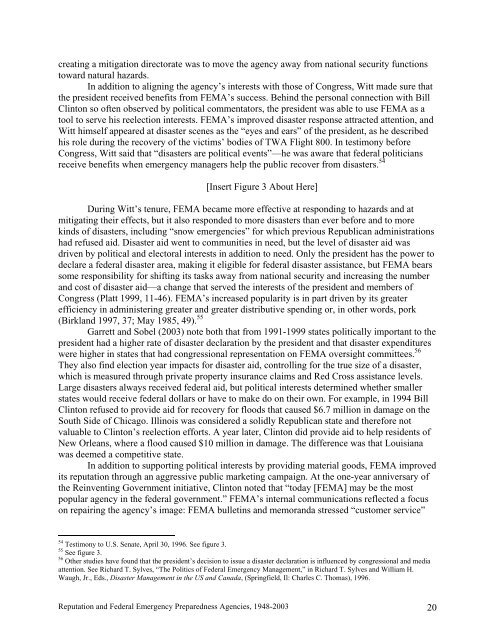Reputation and Federal Emergency Preparedness Agencies, 1948
Reputation and Federal Emergency Preparedness Agencies, 1948
Reputation and Federal Emergency Preparedness Agencies, 1948
You also want an ePaper? Increase the reach of your titles
YUMPU automatically turns print PDFs into web optimized ePapers that Google loves.
creating a mitigation directorate was to move the agency away from national security functions<br />
toward natural hazards.<br />
In addition to aligning the agency’s interests with those of Congress, Witt made sure that<br />
the president received benefits from FEMA’s success. Behind the personal connection with Bill<br />
Clinton so often observed by political commentators, the president was able to use FEMA as a<br />
tool to serve his reelection interests. FEMA’s improved disaster response attracted attention, <strong>and</strong><br />
Witt himself appeared at disaster scenes as the “eyes <strong>and</strong> ears” of the president, as he described<br />
his role during the recovery of the victims’ bodies of TWA Flight 800. In testimony before<br />
Congress, Witt said that “disasters are political events”—he was aware that federal politicians<br />
receive benefits when emergency managers help the public recover from disasters. 54<br />
[Insert Figure 3 About Here]<br />
During Witt’s tenure, FEMA became more effective at responding to hazards <strong>and</strong> at<br />
mitigating their effects, but it also responded to more disasters than ever before <strong>and</strong> to more<br />
kinds of disasters, including “snow emergencies” for which previous Republican administrations<br />
had refused aid. Disaster aid went to communities in need, but the level of disaster aid was<br />
driven by political <strong>and</strong> electoral interests in addition to need. Only the president has the power to<br />
declare a federal disaster area, making it eligible for federal disaster assistance, but FEMA bears<br />
some responsibility for shifting its tasks away from national security <strong>and</strong> increasing the number<br />
<strong>and</strong> cost of disaster aid—a change that served the interests of the president <strong>and</strong> members of<br />
Congress (Platt 1999, 11-46). FEMA’s increased popularity is in part driven by its greater<br />
efficiency in administering greater <strong>and</strong> greater distributive spending or, in other words, pork<br />
(Birkl<strong>and</strong> 1997, 37; May 1985, 49). 55<br />
Garrett <strong>and</strong> Sobel (2003) note both that from 1991-1999 states politically important to the<br />
president had a higher rate of disaster declaration by the president <strong>and</strong> that disaster expenditures<br />
were higher in states that had congressional representation on FEMA oversight committees. 56<br />
They also find election year impacts for disaster aid, controlling for the true size of a disaster,<br />
which is measured through private property insurance claims <strong>and</strong> Red Cross assistance levels.<br />
Large disasters always received federal aid, but political interests determined whether smaller<br />
states would receive federal dollars or have to make do on their own. For example, in 1994 Bill<br />
Clinton refused to provide aid for recovery for floods that caused $6.7 million in damage on the<br />
South Side of Chicago. Illinois was considered a solidly Republican state <strong>and</strong> therefore not<br />
valuable to Clinton’s reelection efforts. A year later, Clinton did provide aid to help residents of<br />
New Orleans, where a flood caused $10 million in damage. The difference was that Louisiana<br />
was deemed a competitive state.<br />
In addition to supporting political interests by providing material goods, FEMA improved<br />
its reputation through an aggressive public marketing campaign. At the one-year anniversary of<br />
the Reinventing Government initiative, Clinton noted that “today [FEMA] may be the most<br />
popular agency in the federal government.” FEMA’s internal communications reflected a focus<br />
on repairing the agency’s image: FEMA bulletins <strong>and</strong> memor<strong>and</strong>a stressed “customer service”<br />
54<br />
Testimony to U.S. Senate, April 30, 1996. See figure 3.<br />
55<br />
See figure 3.<br />
56<br />
Other studies have found that the president’s decision to issue a disaster declaration is influenced by congressional <strong>and</strong> media<br />
attention. See Richard T. Sylves, “The Politics of <strong>Federal</strong> <strong>Emergency</strong> Management,” in Richard T. Sylves <strong>and</strong> William H.<br />
Waugh, Jr., Eds., Disaster Management in the US <strong>and</strong> Canada, (Springfield, Il: Charles C. Thomas), 1996.<br />
<strong>Reputation</strong> <strong>and</strong> <strong>Federal</strong> <strong>Emergency</strong> <strong>Preparedness</strong> <strong>Agencies</strong>, <strong>1948</strong>-2003 20

















